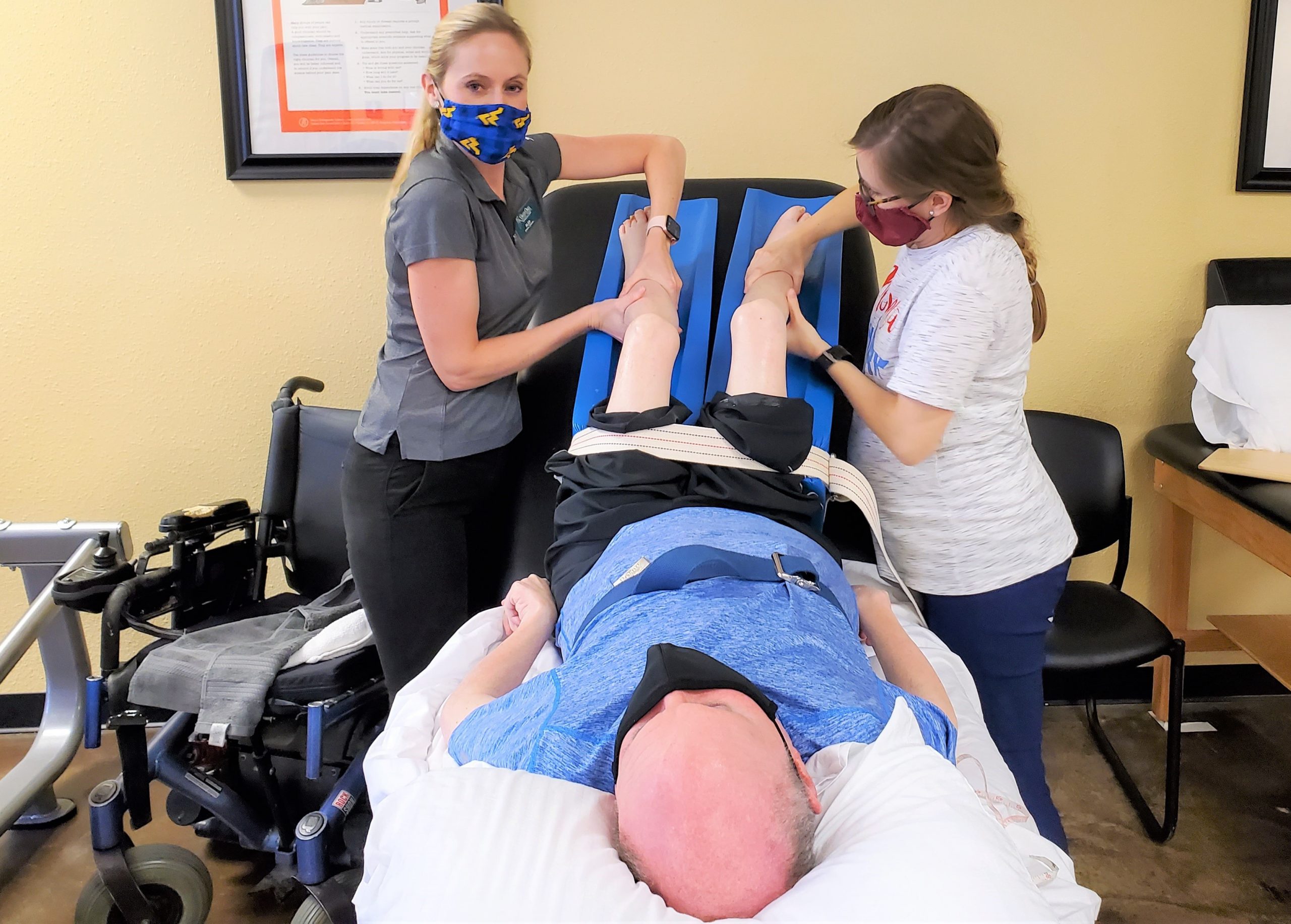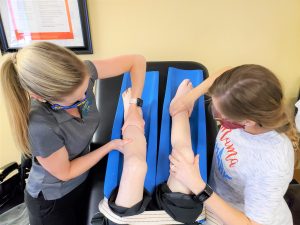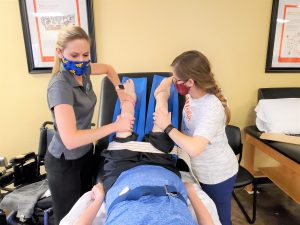Edema Reduction Massage In SMA Patients

As we’ve discussed in previous articles, most patients with SMA sit in a wheelchair all day, therefore increasing the likelihood of experiencing increased swelling in their feet and ankles. For able-bodied individuals, when they walk, their legs are in a gravity dependent position, and there is a natural muscle pump their body uses when their muscles are activated with activities, such as walking, to decrease swelling in lower extremities. My patient with SMA, Michael, is unable to activate muscles in his lower extremities enough to create a muscle pump to naturally decrease swelling independently.
Michael has been struggling with increased swelling in both of his feet and ankles for a very long time now for many reasons, including the position he is in most of the day. He has recently decreased his sodium intake, which will decrease his water retention, therefore decreasing the swelling in his legs. He has also recently begun to wear compression stockings throughout the day to help return fluid back into his lymphatic system, and cycle this fluid through his body. These steps should help in Michael’s attempts to eliminate this fluid buildup naturally, without retaining this excess fluid in his lower extremities. Since Michael has a significant amount of swelling, and has never worn compression stockings before, he is unable to tolerate wearing them for more than a few hours at a time. He’s trying to wear them for a few hours every day, and increase his time each day until he can tolerate a full day of wearing them. This should help the swelling to decrease significantly, making them more tolerable to wear.
While Michael is in therapy, we have begun performing edema reduction massages, to help recirculate the fluid in his feet and ankles to decrease the swelling. This is done by placing his lower extremities in an elevated position, above his heart, to give the fluid a gravity dependent position to flow to with the assistance of the massage. We then start performing a “milking” motion, beginning at the most proximal portion of his swelling, and pushing the swelling proximal, making sure we push this fluid above his knees to help with circulation. We make sure we continue to massage until we are above his knees, to ensure there is no pocket of swelling left behind his knees. We then continue to work our way distally, pushing the swelling proximal, again making sure we push all the way up past his knees.



Before beginning this procedure, Michael was checked by doctors, and cleared for congestive heart failure, ensuring this is a safe procedure to perform on him. If he had been diagnosed with congestive heart failure, pushing fluid back towards his heart would only increase the amount of fluid in his chest, making his heart work harder than it’s already having to, making this a dangerous procedure.
With continuing to ensure Michael intakes less salt, continuing to increase his time wearing compression stockings, and continuing to receive the edema reduction massage during his therapy, his swelling should decrease significantly. This decreased swelling will in turn increase his available dorsiflexion, making it easier for him to use his feet rests on his new chair he will be receiving soon, as well as decrease discomfort he experiences from pressure and swelling in his feet and ankles, and making it easier to wear shoes and socks.
======================== Patient Perspective ========================

Swelling or edema in my ankles and feet have been a problem that I’ve battled throughout my life, but as I’ve aged, this swelling has caused some health issues that I never thought I would have. People like myself, who sit in wheelchairs for the majority of the day, tend to have this swelling because of either poor circulation, lack of activity, the way we sit it in our wheelchairs, poor diet or a combination of multiple symptoms. It was only in the past couple of years that this swelling has become an issue that needed to be addressed, and physical therapy was one of the best solutions that I found.
While I try to eat a balanced meal every day, I’m like everyone else. Every once in a while, nothing sounds better than a greasy double meat cheeseburger, and while I try not to make this a regular meal, I will say that my willpower definitely needs help. Someone once told me that if I wanted to eat something that had zero sodium, no fat, no carbohydrates and no preservatives, the best thing to eat would be a cardboard box. While this may sound funny, I was shocked to find out how much sodium is in foods that we get at different restaurants. I did an Internet search on a couple of the restaurants that I had ordered from over the past couple weeks, and the majority of them had a nutritional section. When I opened this nutritional section, I looked up the foods that I had ordered and realized that I was eating between 3000 and 4000 mg of salt each day. The recommended allowance of sodium is 2000 mg or less each day, and after putting 2 and 2 together, I quickly realized where the swelling was coming from.
After getting clearance from my doctor, my physical therapists, Emily and Alex, along with their physical therapy students, now perform an edema reduction massage on my feet and ankles. This procedure basically pushes some of the fluid retention back up toward my upper extremities, giving this fluid a better way to access the pathway to my heart, so it can disperse the fluids more evenly throughout the rest of my body. [This procedure can be viewed in the video at the top of this article.]
This edema reduction massage has now become a standard procedure that they perform on me every other week, when I transfer from my wheelchair to the therapy table. We’ve been doing this massage on my feet and ankles for the past month, and I can attest to the fact that it actually works. The swelling has gone down considerably, and my feet and ankles no longer hurt like they used to.

